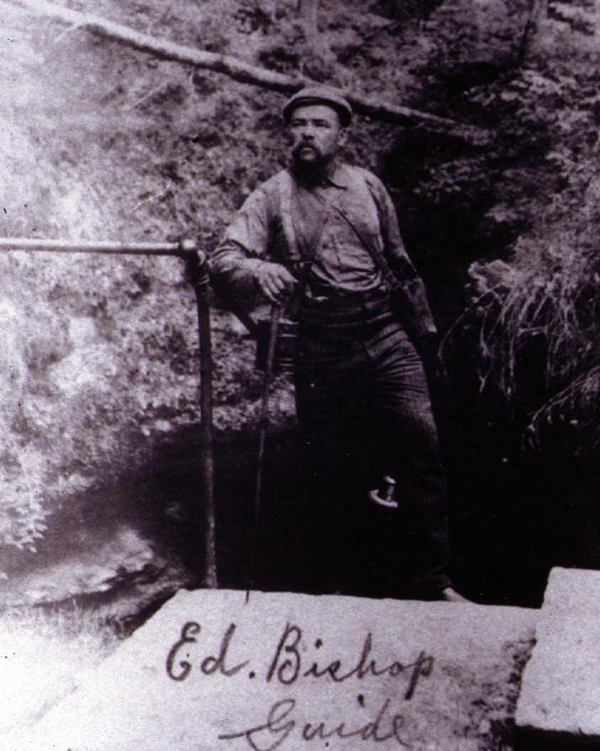Last updated: January 26, 2022
Person
Ed Bishop

Many guides have left a lasting legacy over the last two centuries of exploration and tourism at Mammoth Cave. Ed Bishop began guiding tourists at Mammoth Cave in 1886, and within thirty years, had become one such guide.
During Bishop’s career at Mammoth Cave both he and his employer likely purported Ed Bishop to be the great-nephew of deceased famous cave guide, Stephen Bishop. Decades later, there is no documentation to support this ancestry. While it seems more likely that this was a business tactic to capitalize on Stephen Bishop’s fame, the full story of this history remains unknown.
In 1893, Bishop married Josephine “Josie” Curd of Barren County, Kentucky. Their only child, Chancie, died in infancy. The short marriage ended with the death of Josie from tuberculosis.
Bishop’s second marriage was to Miss Willie Lewis in March 1900. The marriage produced four children: Stephen, Maude, Tandy, and Anna. An accomplished explorer of Mammoth Cave, Bishop named four of his cave discoveries, Stephen’s Way, Maud’s Grotto, Tan’s Pit and Runt’s Dome after his children.
After a sightseeing tour of Mammoth Cave in 1908, German cartographer Max Kaemper arranged to receive room and board in exchange for creating a detailed map of the cave. With Bishop serving as guide, the two explorers found many new discoveries and charted many previously unknown miles of the cave. Their exploits remain commemorated in the names of Kaemper Hall, Bishop’s Pit, and the Kaemper Map.
Bishop resigned from his post as guide at Mammoth Cave and moved with his third wife, Dora English, to Illinois in 1917. That same year, Donna Bullock had been appointed in charge of business matters at the cave hotel. Subsequently, many of the employees’, some with decades of tenure, felt compelled to complain to trustee Albert. C. Janin about her unfair treatment of the guides. Although the map and many of the stories of exploration which Bishop had been a part of temporarily flickered into obscurity, his importance as a guide was not soon forgotten.
In 1921, the Mammoth Cave business had a competitor. George Morrison began conducting tours of newly discovered passages via a new entrance which he had dug into an extension of Mammoth Cave. Morrison’s New Entrance Guidebook included a comment regarding Bishop:
"The real guide was Ed Bishop. He instructed Hunt how to reach the New Discovery from the Cathedral Dome route and Hunt instructed Bob Lively, but during 1916 and 1917 it was necessary to wait for Bishop, to make the trip.”
From Illinois, Bishop eventually moved to Indiana, his final home. After his death in 1931, his body was returned to Kentucky to be interred in an unmarked grave alongside his first wife Josie and their infant daughter Chancie.
In due time, new discoveries were made at Mammoth Cave. These included the rediscovery of the Kaemper Map and its impressive representation of some thirty-five miles of the cave. Kaemper’s diary of the approximately eight-month-long Kaemper-Bishop saga of exploration was also located.
Bishop has been recognized as an integral part of the Mammoth Cave guide. In 2010, two headstones were purchased and set with money donated by Mammoth Cave guides and Cave Research Foundation members. One commemorates the short life of little Chancie. The other recognizes the lives of Ed and Josie Bishop and the thirty years that Bishop spent guiding and exploring in Mammoth Cave.
